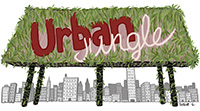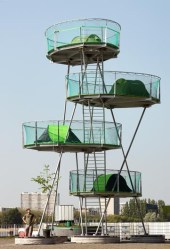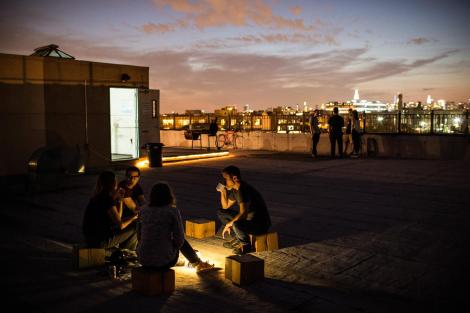
Thomas Stevenson Roughing it with Bivouac NYC.
“It was a time to socialize and look at the stars,” says 24-year-old Ariel Abrahams, describing a recent camping trip. He talks about “the rush of the water from the creek, the chirping of birds,” and the trees standing close around him.
The hitch? Those natural sights and sounds were only in Abrahams’ imagination. His tent was actually pitched atop a Brooklyn warehouse.
The man behind this “camp out,” conceptual artist Thomas Stevenson, calls his collection of wood-framed, canvas tents Bivouac NYC. Bivouac, a word known better among mountaineers than urban denizens, is a French term for a temporary campsite. Participants — up to 18 at a time — sleep for a night or two under the stars, their shelters often tucked amid cone-topped water tanks, in the hopes of experiencing the Great Connect by disconnecting.
Now in its second summer, the urban camping project has caught on, enough so that Stevenson has been asked to bring it to Boston, London, and possibly California.
I know what you’re thinking: Camping, sure — but in the city?
The appeal, aside from not having to “drop trou” in the woods, is the chance to experience urban environments in a new way, Stevenson says. “Even though you’re in the heart of a city, it’s quiet up on the roofs and suddenly people begin to understand what they might be able to do without.”
Stevenson launched Biouvac in the fall of 2011, only days after the Occupy movement emerged. For many people, the appearance of tents in Zuccotti Park, right in the heart of a city, was startling at first, he says. But their eyes adjusted, and Stevenson’s project began to look a little less outlandish — even fun.
For the past several years, artists around the world have been designing innovative ways people might camp in inner cities, going so far as to reimagine the tent for more urban surrounds. They’re on one edge of a broader movement that is getting city residents back out into nature — right in their own front yards (or right on their own rooftops, as the case may be).
In Amsterdam, import.export Architecture designed a mobile, raised, urban “tentscraper” camping unit, designed to instantly create a mini campground. In Berlin, Tentstation set up campsites near the city’s main train station and also near Brandenburg Gate. Last month, Urban Campsite Amsterdam started offering customers a chance to stay in artistically rethought “tents” — inside a plastic container resembling a cement mixer.
Tent manufacturers are also rethinking camping, creating shelters that are tethered to tree trunks or suspended in the air. Elsewhere, tents have become art canvases portraying the heavens, tropical scenes, or great works of art.
Meanwhile, cities such as Chicago, New York, Houston, and San Francisco have established urban camping programs, often geared toward families or neighborhood youths. Registration to pitch a tent in New York City’s Central Park by way of its Urban Park Rangers initiative are frequently snatched up by couples, some whom have written about the experience. Many of the nation’s zoos hold overnight family camping adventures. In Europe, proponents are pitching camping as a greener form of tourism.
What is happening to create this tent revival beneath a steel sky?
Environmentalists and others cite the city dweller’s deep-rooted need to reconnect to nature. That was, after all, why some of the great parks were designed, long before concrete and asphalt so fully blanketed the urban landscape: The human “ancient brain” “needs that connection to nature,” says Tim Beatley, professor of sustainable communities at the University of Virginia and author of the book, Biophilic Cities.
Richard Louv, the author who coined the phrase “nature deficit disorder” explains that, as of 2008, more people live in cities worldwide than any other time in history. “People are hungry for a nature-rich life,” he says, “a new kind of city in which lives a nature-rich civilization.”
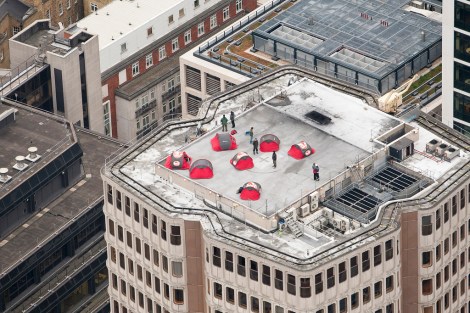
BovrilThis “extreme urban campsite” on a London rooftop was billed as a demonstration in low-cost living for cash-crunched Brits.
In re-imagining cities as campgrounds, American landscape designer Adam Anderson in his blog Design Under Sky writes:
A new wilderness is developing. Cities are rapidly growing, becoming more complex, and rather than locking ourselves up in our protective boxes, what if we found a new way to test ourselves in the throws of the urban wilderness? Rather than becoming intimately involved with nature, listening and understanding the landscape, we rediscover urbanity in a completely new way. Smells, sounds, people, paths, roads, parks, architecture all become things of exploration rather than simply parts of the sum.
A new school of city planners and architects and local government leaders more attuned to ideas of wild urbanity and E.O. Wilson’s biophilia hypothesis are already beginning to transform the metropolis, adding more parks and lacing natural habitat amid bustling urban landscapes.
In Chicago and surrounding communities, the Forest Preserve District of Cook County has drawn up a public camping master plan that, beginning next year, will overhaul five camp locations close to the city, adding modern shower and toilet facilities, tent pads, small cabins, and upgrades throughout. Drawn up after several with input from the community, the comprehensive plan will allow locals “to get to a forest preserve and into the woods in merely 20 minutes from downtown Chicago,” says Arnold Randall, the district’s superintendent.
The city for more than a decade has offered youth and family camping programs in many neighborhood parks. And on the 91-acre Northerly Island, a human-made peninsula off the shore of Lake Michigan, the Chicago Park District’s family camping program will be greatly enhanced under plans drawn up by architect Jeanne Gang and Studio Gang Architects that will transform part of the island into woodland, marsh, and wildlife habitat.
In late June, several families camped on Northerly Island the night of the supermoon. Campers arrived by bus and even bicycle, as the tents were provided by the park district. Some were young parents, others grandparents with kids in tow.
As dusk approached, to the east, the grand lunar orb seemed to rise from the lake. Directly west, Chicago’s skyline shot up from the landscape, no less stunning in its glow.
For participants, sleeping with the lake and the city outside their tent flap offered an urban experience unlike anything else. “I was the best camping experience I ever had,” a young child who had never camped before told one of the organizers. Adults found that sleeping out with the city so near forever changed their idea of what a campsite should be, and where: It doesn’t always have to be in the woods.
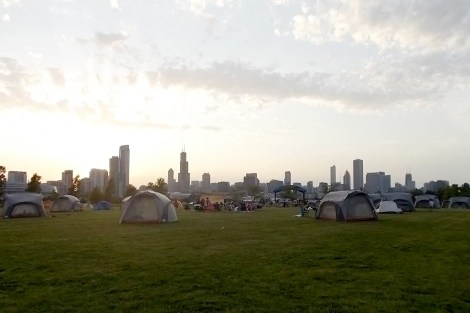
Chicago Park DistrictWaiting for the supermoon on Chicago’s Northerly Island
Coming tomorrow: A slide show of crazy, space age tents.


